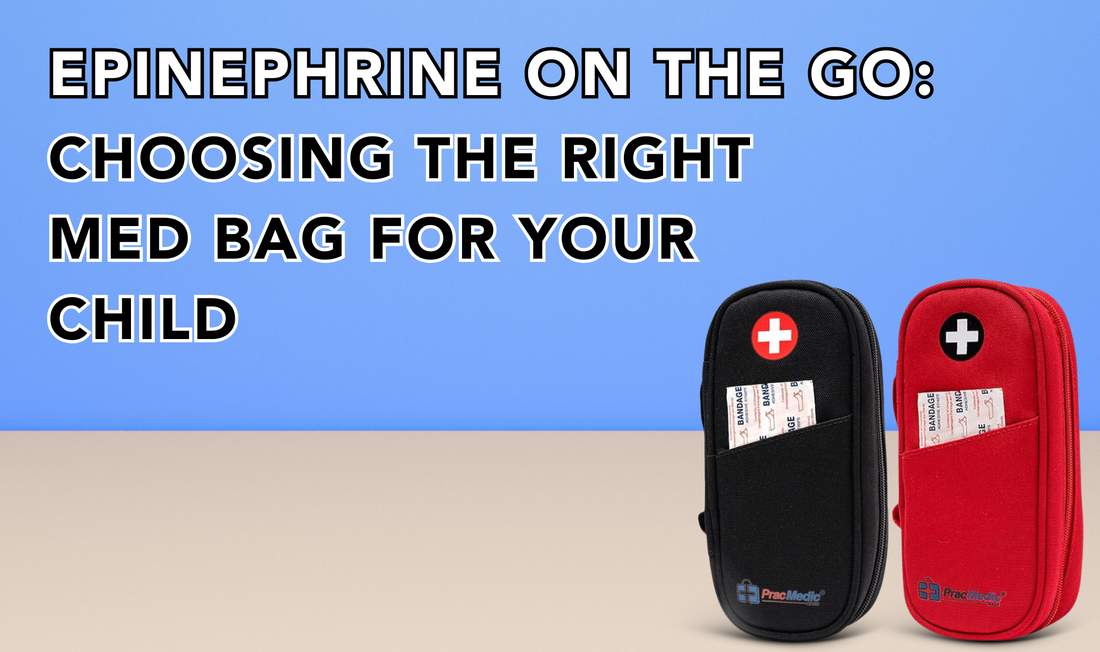
Epinephrine on the Go: Choosing the Right Med Bag for Your Child
Share
Raising a child with food allergies or severe allergic reactions means living with a heightened level of awareness and readiness. Epinephrine auto-injectors—commonly known by brand names like EpiPen or Auvi-Q—are life-saving devices that need to be available at a moment’s notice. But having the medication is only part of the equation. Where and how it’s stored matters just as much.
That’s where the right med bag comes in.
For parents, caregivers, and kids, the perfect epinephrine carry case balances safety, accessibility, durability, and comfort—without sacrificing your child’s confidence or independence. In this blog, we’ll guide you through why a designated med bag is essential and how to choose the right one for your child’s lifestyle.
Why Every Child Needs a Dedicated Med Bag
Let’s face it: shoving an EpiPen into the bottom of a school bag or a zip-lock pouch isn't exactly reliable—or safe.
A proper medicine bag:
-
Keeps epinephrine protected from damage or heat
-
Makes meds easy to find in an emergency
-
Gives your child a sense of responsibility and ownership
-
Reduces stress for parents, caregivers, and teachers
-
Helps substitute carers know exactly where to find life-saving meds
Whether your child is headed to school, daycare, sports practice, or an overnight trip, a dedicated med case ensures their medication is stored securely, visibly, and accessibly.
What to Look for in a Med Bag for Kids
When selecting a med bag, it’s not just about looks—though a design your child loves definitely helps. It’s about function, comfort, and everyday usability.
Here are the key features to prioritise:
1. Size & Capacity
The bag must comfortably fit at least two epinephrine auto-injectors, per most allergy action plans. Some bags also have room for:
-
Antihistamines
-
Asthma inhalers
-
Nasal sprays or wipes
-
Emergency contact cards or action plans
Choose a size that suits your child’s daily needs—but isn’t so bulky that they leave it behind.
2. Insulation & Temperature Protection
Epinephrine is temperature-sensitive. Exposure to high heat or freezing conditions can reduce its effectiveness.
Look for a case that’s:
-
Insulated
-
Weather-resistant
-
Built for both hot and cold environments
3. Kid-Friendly Design
Kids are more likely to carry something they feel good about. That’s why we created colourful and practical options like the Sammie Epipen Case, designed especially for children.
Look for:
-
Bright colours (easy to find in a backpack)
-
Fun designs or patterns
-
Soft, lightweight material
-
Labels like “Meds Inside” or custom name tags
A cool-looking med bag turns “ugh” into “awesome” real quick.
4. Ease of Access
In an emergency, every second counts. Choose a bag that:
-
Zips open quickly
-
Organises contents so meds are visible
-
Includes internal straps or mesh pockets to hold meds in place
At PracMedic Bags, we use elastic loops and open mesh compartments so everything stays neat, secure, and visible—even when you're in a hurry.
5. Portability
The ideal case is easy for your child to carry—and even easier for adults to spot. Look for:
-
Wristlets for short trips
-
Carabiner clips to attach to backpacks
-
Crossbody or shoulder straps for active kids
-
Belt loops for school uniforms or outdoor days
Lightweight, clip-on portability means the meds are always close—never forgotten in another bag.
6. Durability
Let’s be honest: kids drop things. A lot. Their med case needs to survive:
-
Schoolyard tumbles
-
Backpack squishes
-
Spilled water bottles
-
Unexpected rainstorms
Choose one made from strong, water-resistant fabric with solid zippers (YKK or similar) and a sturdy interior.
7. Clear Labelling for Emergencies
Even the most organised case won’t help if someone else can’t identify it during a crisis.
Choose a bag with:
-
Clear MEDS INSIDE labelling
-
Bright medical cross symbols
-
A place to insert emergency info or an allergy action plan
Our PracMedic Bags Kids Medicine Cases include printed cards for this purpose—so teachers, coaches, and caregivers know what’s inside and how to respond.
How to Involve Your Child in the Process
Ownership = confidence.
Instead of doing it all for them, let your child:
-
Choose their favourite colour or pattern
-
Help pack the case each morning
-
Clip it to their backpack or carry it on their wrist
-
Practise how to explain what’s inside to an adult
This helps normalise their allergy and encourages self-advocacy—skills they’ll carry for life.
Real-Life Moments: When the Right Bag Makes a Difference
Parents in our PracMedic Bags community have shared powerful stories that remind us just how important a simple med case can be:
🗣️ “My daughter used to hide her Epipen in her lunch bag. Now, she proudly wears her Red Sammie Case to school and knows exactly how to use it.”
🗣️ “We were at a playground when my son had a reaction. His Compact Epipen Case was clipped to my belt—we got the EpiPen out in seconds. No digging, no panic.”
🗣️ “My son’s teacher said it was the first time she’d seen such a clearly labelled, easy-to-use med kit. It gave her more confidence too!”
When the tools are practical, attractive, and accessible, they don’t just help your child—they support the entire care network around them.
Tips for Daily Med Bag Success
Want to make using a med bag second nature for your child? Try these tips:
✅ Store it near their school bag so it’s never forgotten
✅ Refill and check expiry dates monthly
✅ Include a copy of their allergy action plan inside
✅ Use name tags or contact cards in case it’s misplaced
✅ Make it part of the routine: “Shoes? Check. Water bottle? Check. Med bag? Check.”
